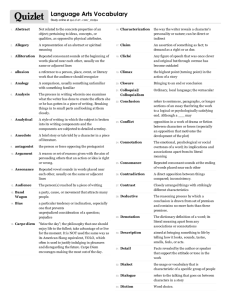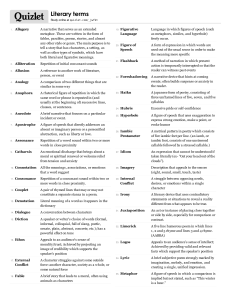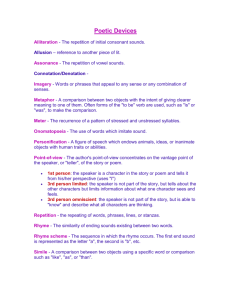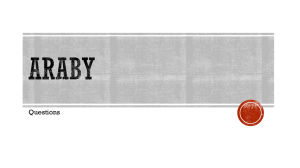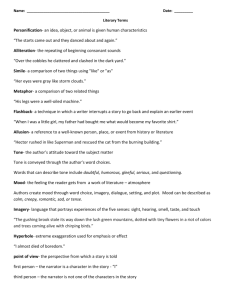English 11 Regents Literary Terms
advertisement
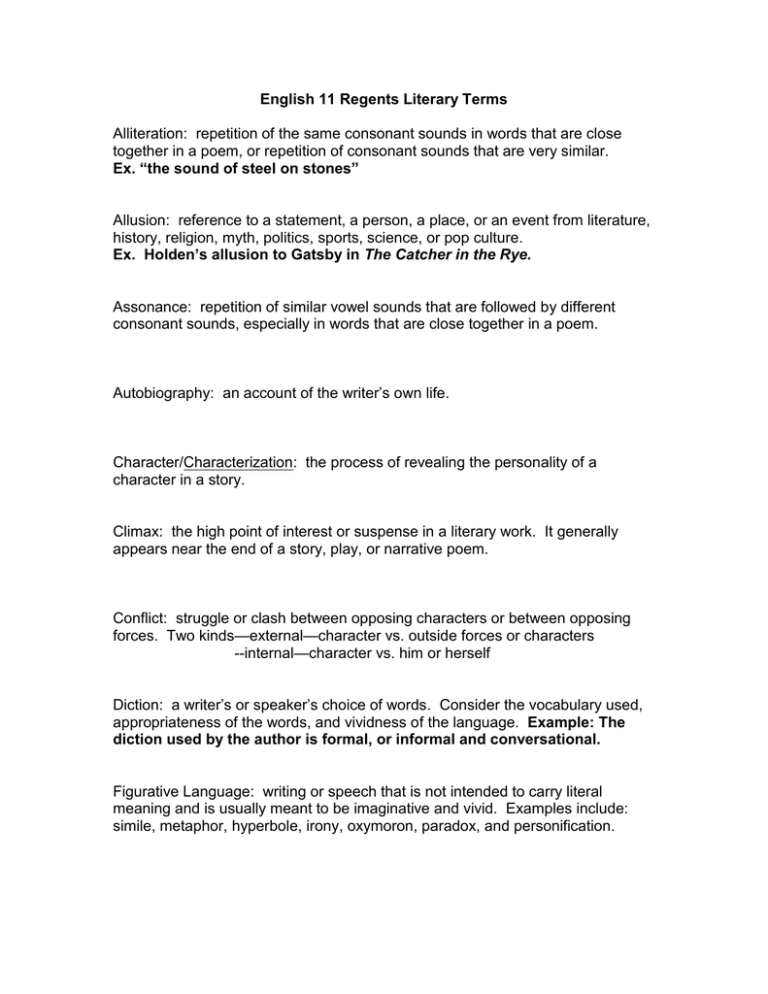
English 11 Regents Literary Terms Alliteration: repetition of the same consonant sounds in words that are close together in a poem, or repetition of consonant sounds that are very similar. Ex. “the sound of steel on stones” Allusion: reference to a statement, a person, a place, or an event from literature, history, religion, myth, politics, sports, science, or pop culture. Ex. Holden’s allusion to Gatsby in The Catcher in the Rye. Assonance: repetition of similar vowel sounds that are followed by different consonant sounds, especially in words that are close together in a poem. Autobiography: an account of the writer’s own life. Character/Characterization: the process of revealing the personality of a character in a story. Climax: the high point of interest or suspense in a literary work. It generally appears near the end of a story, play, or narrative poem. Conflict: struggle or clash between opposing characters or between opposing forces. Two kinds—external—character vs. outside forces or characters --internal—character vs. him or herself Diction: a writer’s or speaker’s choice of words. Consider the vocabulary used, appropriateness of the words, and vividness of the language. Example: The diction used by the author is formal, or informal and conversational. Figurative Language: writing or speech that is not intended to carry literal meaning and is usually meant to be imaginative and vivid. Examples include: simile, metaphor, hyperbole, irony, oxymoron, paradox, and personification. Flashback: scene in a movie, play, short story, novel, or narrative poem that interrupts the present action of the plot to “flash” backward and tell what happened at an earlier time. Foreshadowing: the use of clues to hint at events that will occur later in the plot. Example: In Of Mice and Men the deaths of both the mouse and puppy foreshadow the death of Curly’s wife. Genre: denotes a type of literature Ballad: a song that tells a story Short story: short, concentrated, fictional prose narrative Historical novel: makes use of events from the historical past to add interest to the narrative Hyperbole: extreme exaggeration for effect Imagery: descriptive or figurative language used in literature to create word pictures for the reader. These pictures or images are created by details of sight, sound, taste, touch, smell, or movement. Irony(three kinds): situational irony—contrast or discrepancy between expectancy and reality—between what is said and what is really meant, between what is expected to happen and what really does happen, or between what appears to be true and what is really true dramatic irony—occurs when the audience or the reader knows something important that a character in a play or story does not know. Example: The audience knows that the sword in the duel scene in Hamlet is poisoned. verbal irony—a writer or speaker says one thing but really means something completely different (sarcasm). Metaphor: comparison of two unlike things without using “like” or “as” Example: My stomach was a melon split wide inside my skin. —Naomi Shihah Nye Motif: the repetition or variations of an image or idea in a work used to develop theme or characters Narrator: a speaker or character who tells a story. The omniscient narrator is allknowing, while the limited narrator knows only what one character does. Oxymoron: a figure of speech wherein the author groups contradictory terms to suggest a paradox (a paradox is something that seems to oppose common sense, but contains some truth) Example: “cruel kindness” Personification: special kind of metaphor in which a nonhuman thing or quality is talked about as if it were human—that is, it is described as behaving and feeling the way people do. Example: Emily Dickinson describes the wind as tapping like a tired man. Plot: series of related events that make up a story or drama Point of view: vantage point from which the writer tells the story. three kinds—omniscient (all knowing)—person telling the story knows everything there is to know about the characters and their problems. --first-person—one of the characters is actually the narrator telling the story, using the pronoun I. --third-person limited—the narrator, who plays no part in the story, zooms in on the thoughts and feelings of just one character. Protagonist/Antagonist: main character/character that opposes the main character Resolution: the moment when all the problems are resolved one way or another and the story is closed Rhetorical question: one that does not expect an explicit answer; it is used to pose an idea to be considered by the speaker or audience Sarcasm: a comic technique that ridicules through caustic language; tone and attitude may both be described as sarcastic in a given text if the writer employs language, irony and wit to mock or scorn Setting: time and place of a literary work. The description of it often establishes the mood of the story. Simile: indirect comparison that uses like or as to link the differing items in the comparison. Example: “Alexandra is as bright as a bulb.” Stanza: a group of consecutive lines in a poem that form a single unit Stream of consciousness: presents thoughts as if they were coming directly from a character’s mind. Instead of being arranged in chronological order, the events of the story are presented from the character’s point of view, mixed in with the character’s feelings and memories just as they might spontaneously occur in the mind of a real person. Structure: the shape of the work Example: The authors use more dialogue than narration. Symbol: a person, a place, a thing, or an event that stands for itself and for something beyond itself as well Theme: the central idea about people or about life in a work of literature Tone: the attitude a writer takes toward the audience, a subject, or a character. It can be described by a single adjective i.e. serious, playful, bitter…

